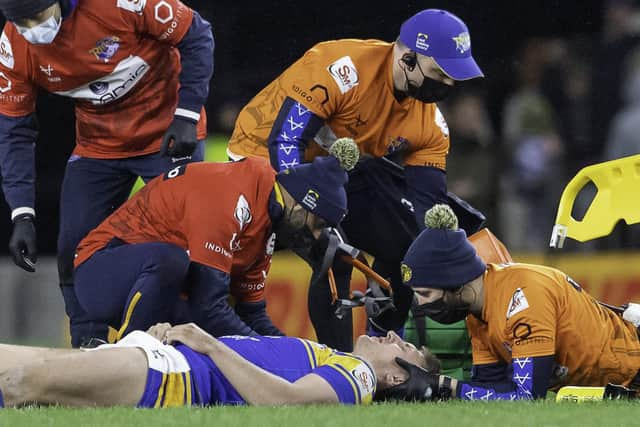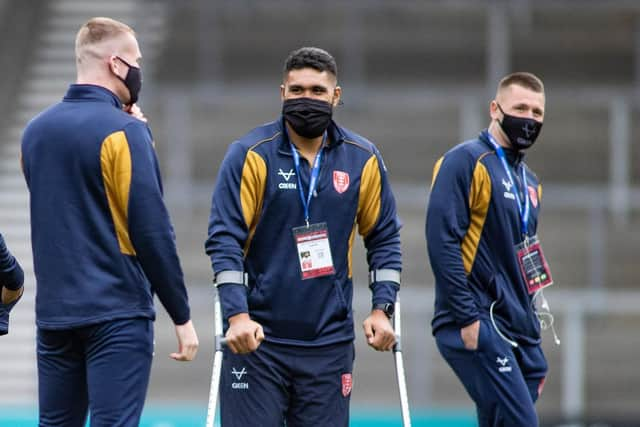Clampdown on head shots is for the good of the game – Peter Smith
and live on Freeview channel 276
It is never nice to see any player get injured, particularly when the stretcher comes on and the casualty leaves the field with his neck in a brace, as Rhinos’ Alex Mellor did seven days ago.
It is only a couple of years since – on the same day Rob Burrow made his farewell appearance for Rhinos against Bradford Bulls – Hull KR forward Mose Masoe suffered a career-ending spinal injury in a pre-season game away to Wakefield Trinity.
Advertisement
Hide AdAdvertisement
Hide AdIt was an innocuous-looking incident, of the sort seen in dozens of games over the course of a campaign, but this time Masoe didn’t get up.


There were fears he would never walk again, but thankfully, Masoe has made a better than expected recovery – though the injury was still life-changing – and Mellor was cleared of any serious damage following hospital tests.
But incidents like those highlight the dangers of fast and physical collision sport, which gets more so every year.
As mentioned in this column a couple of weeks ago, there is greater recognition now of the dangers of concussion and blows to the head and the sport is taking steps to mitigate that.
Advertisement
Hide AdAdvertisement
Hide AdAs long as tackling is permitted, it won’t be possible to avoid some contact above the shoulders, but rugby league is attempting to lessen the risks.


From this season, any player failing a head injury assessment during a game or training will be automatically stood down for an 11-day period and stringent tests have to be passed before he or she can play again.
That can be frustrating for players, coaches and fans, but – as Mellor stressed in an interview with the YEP this week – it is the right approach.
As is the current clampdown on any foul play to the head or after the ball has been passed.
Advertisement
Hide AdAdvertisement
Hide AdInevitably, that has led to suggestions the game has ‘gone soft’, but that is clearly not the case. ‘Gone sensible’ is a better way of putting it.


The ‘game is dead’ brigade need to realise that will literally be the case if rugby league is on the wrong end of expensive legal action by former players whose quality of life has been affected by on-field damage.
Nobody wants to see the best players sent-off, sin-binned or missing matches because of suspension. The number of cards being waved around in the opening three Betfred Super League rounds has had a bearing on the quality of rugby on show, but it’s up to players and coaches to alter their behaviour. The game is evolving and new laws or policies quickly become accepted practice. However, it is important the authorities get things right, after matches as much as during them.
It’s slightly easier in televised games when the man in the middle has a video assistant with access to instant replays, but referees often have to make rapid decisions.
Advertisement
Hide AdAdvertisement
Hide AdThe approach this year seems to be ‘if in doubt, get a card out’, which is understandable in the current climate, but players also have to make decisions in a split second and, inevitably, they won’t always get it right.
The liability now is with the tackler, even if the player on the receiving end is also at fault.
Bureta Faraimo was sin-binned and subsequently suspended for two matches for a grade B high tackle, on Will Dagger, in Castleford Tigers’ defeat at Hull KR last Friday.
The RFL’s match review panel notes stated: “High tackle – When tackling or attempting to tackle makes contact with the head or neck of an opponent. Reckless – tried to tackle but reckless about outcome.”
Advertisement
Hide AdAdvertisement
Hide AdDagger made a catch and was going down when Faraimo hit him. Moments later, it would have been a perfect tackle.
Judging the difference between careless and reckless isn’t easy, particularly without hearing from the player involved, but makes a difference to the eventual punishment.
Under the current disciplinary system, charges – and therefore suspensions – in most cases are issued without the accused player being able to state his case or offer a defence. And if he does opt to do that, he risks having a ban increased, as happened to Rhinos’ James Bentley earlier this year.
That is not right. The RFL must protect players, but that includes ones accused of misconduct. If harsher sanctions are to be applied on the field, the governing body needs to come up with a better system off it, not one which deters defendants from stating their case.
Advertisement
Hide AdAdvertisement
Hide AdSupport the YEP and become a subscriber today. You’ll enjoy unlimited access to the latest on Leeds United and Leeds Rhinos. With our sports digital subscription, you’ll also see fewer ads, enjoy faster load times, and get exclusive content. Click here to subscribe.
Comment Guidelines
National World encourages reader discussion on our stories. User feedback, insights and back-and-forth exchanges add a rich layer of context to reporting. Please review our Community Guidelines before commenting.